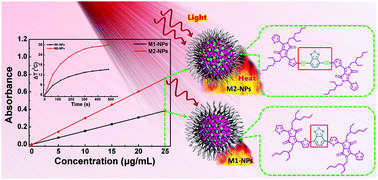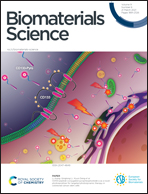Molecular engineering to boost the photothermal effect of conjugated oligomer nanoparticles†
Abstract
Photothermal therapy has great potential in the treatment of diseases; however, the photothermal property is a key factor limiting the therapeutic effect of photothermal materials. Most strategies to improve the photothermal performance of photothermal materials focus on increasing their photothermal conversion efficiency (PCE) by promoting the non-radiative transition process. However, a strong ability to absorb light is also a significant factor to enhance the photothermal performance of materials because it determines the amount of acquired energy to transform to heat. Therefore, in this work, we utilized molecular engineering to introduce ethynyl into the molecular structure of conjugated molecules to significantly enhance their ability to absorb light and improve their photothermal performance. The M2-NPs made of the conjugated oligomer named M2 with ethynyl exhibited a two-fold greater mass extinction coefficient (30.26 L g−1 cm−1) than that of nanoparticles M1-NPs with a similar structure but no ethynyl (15.34 L g−1 cm−1). Furthermore, M2-NPs could kill 97% of bacteria at a concentration of 7.0 μg mL−1, which is less than that of M1-NPs (13.0 μg mL−1). In addition, M2-NPs could successfully treat the infected wounds in mice with good biosafety. This provides a new idea for effectively improving the photothermal performance of photothermal materials via molecular design and inspires the further development of novel superior photothermal agents.



 Please wait while we load your content...
Please wait while we load your content...